Superman
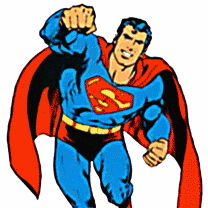
Digital Comics: Superman CArtoon 1941
http://COMICSCANS.NET has all the best digital comic book entertainment you’ve been looking for. Get the rest of the classic Max Fletcher SUPERMAN CARTOONS at http://comicscans.net. Sign up to receive the links to download all your favorite digital comics and cartoons. Get the best in digital comics at http://www.comicscans.net featuring comics on DVd from the golden age of comics. Captain Marvel digital comics, Plastic Man comic scans and hundreds of other digital comics titles.
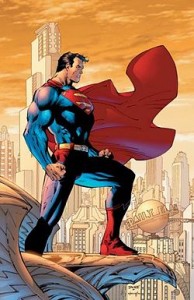 Promotional art for Superman vol. 2, #204 (April 2004) by Jim Lee and Scott Williams
Promotional art for Superman vol. 2, #204 (April 2004) by Jim Lee and Scott Williams
Superman is a fictional character, a superhero that appears in comic books published by DC Comics, and is widely considered an American cultural icon. Superman was created by writer Jerry Siegel and artist Joe Shuster, high school students living in Cleveland, Ohio, in 1933; the character was sold to Detective Comics, Inc. (later DC Comics) in 1938. Superman first appeared inAction Comics #1 (June 1938) and subsequently appeared in various radio serials, television programs, films, newspaper strips, and video games. With the success of his adventures, Superman helped to create the superhero genre and establish its primacy within the American comic book.
Superman’s appearance is distinctive and iconic. He usually wears a blue costume, red cape, and stylized red-and-yellow “S” shield on his chest. This shield is used in a myriad of media to symbolize the character.
The origin story of Superman relates that he was born Kal-El on the planet Krypton, before being rocketed to Earth as an infant by his scientist father Jor-El, moments before Krypton’s destruction. Discovered and adopted by a Kansas farmer and his wife, the child is raised as Clark Kent and imbued with a strong moral compass. Very early he started to display superhuman abilities, which upon reaching maturity, he resolved to use for the benefit of humanity. Superman resides and operates in the fictional American city of Metropolis. As Clark Kent, he is a journalist for a Metropolis newspaper called the Daily Planet. Superman’s archenemy is supervillain Lex Luthor. Superman has fascinated scholars, with cultural theorists, commentators, and critics alike exploring the character’s impact and role in the United States and worldwide. The character’s ownership has often been the subject of dispute, with Siegel and Shuster twice suing for the return of legal ownership. Superman placed first on IGN‘s Top 100 Comic Book Heroes in May 2011.
Publication history – List of Superman comics
Creation and conception
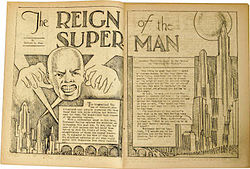 “The Reign of the Superman” in the fanzineScience Fiction, #3 (June 1933)
“The Reign of the Superman” in the fanzineScience Fiction, #3 (June 1933)
Jerry Siegel and Joe Shuster, then students at Cleveland’s Glenville High School, first conceived Superman as a bald telepathic villain bent on world domination. The character first appeared in “The Reign of the Superman“, a short story fromScience Fiction: The Advance Guard of Future Civilization #3, a fanzine published by Siegel in 1933. Siegel re-envisioned the character later that year as a hero bearing no resemblance to his villainous namesake, with Shuster visually modeling Superman on Douglas Fairbanks Sr. and his bespectacled alter ego, Clark Kent, on a combination of Harold Lloyd and Shuster himself, with the name “Clark Kent” derived from movie stars Clark Gable and Kent Taylor. Lois Lane was modeled on Joanne Carter, who later became Siegel’s wife. Comic strips such asLi’l Abner and Dick Tracy influenced its original artwork. Siegel and Shuster then began a six-year quest to find a publisher. Titling it The Superman, Siegel and Shuster offered it to Consolidated Book Publishing, who had published a 48-page black-and-white comic book entitled Detective Dan: Secret Operative No. 48. Although the duo received an encouraging letter, Consolidated never again published comic books. Shuster took this to heart and burned all pages of the story; the cover surviving only because Siegel rescued it from the fire. Siegel and Shuster each compared this character to Slam Bradley, an adventurer the pair had created for Detective Comics #1 (March 1937).
Siegel, believing that Superman would not progress with Shuster, contacted artists Tony Strobl, Mel Graff, and Russell Keaton as potential collaborators on the strip. Artwork produced by Keaton based on Siegel’s treatment shows the concept evolving. Superman is now sent back in time as a baby by the last man on Earth, where he is found and raised by Sam and Molly Kent. However, Keaton did not pursue the collaboration, and soon Siegel and Shuster were back working together on the character.
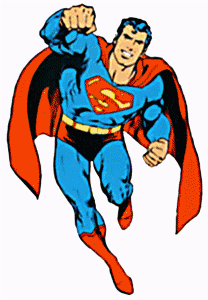 The pair re-envisioned the character, who became more of a hero in the mythic tradition, inspired by such characters as Samsonand Hercules, who would right the wrongs of Siegel and Shuster’s times, fighting for social justice and against tyranny. It was at this stage the costume was introduced, Siegel later recalling that they created a “kind of costume and let’s give him a big S on his chest, and a cape, make him as colorful as we can and as distinctive as we can.” The design was based in part on the costumes worn by characters in outer space settings published in pulp magazines, as well as comic strips such as Flash Gordon, and also partly suggested by the traditional circus strong-man outfit, which comprised a pair of shorts worn over a contrasting bodysuit. However, the cape has been noted as being markedly different from the Victorian tradition. Gary Engle described it as without “precedent in popular culture” in Superman at Fifty: The Persistence of a Legend. The circus performer’s shorts-over-tights outfit was soon established as the basis for many future superhero outfits. This third version of the character was given extraordinary abilities, although this time of a physical nature as opposed to the mental abilities of the villainous Superman.
The pair re-envisioned the character, who became more of a hero in the mythic tradition, inspired by such characters as Samsonand Hercules, who would right the wrongs of Siegel and Shuster’s times, fighting for social justice and against tyranny. It was at this stage the costume was introduced, Siegel later recalling that they created a “kind of costume and let’s give him a big S on his chest, and a cape, make him as colorful as we can and as distinctive as we can.” The design was based in part on the costumes worn by characters in outer space settings published in pulp magazines, as well as comic strips such as Flash Gordon, and also partly suggested by the traditional circus strong-man outfit, which comprised a pair of shorts worn over a contrasting bodysuit. However, the cape has been noted as being markedly different from the Victorian tradition. Gary Engle described it as without “precedent in popular culture” in Superman at Fifty: The Persistence of a Legend. The circus performer’s shorts-over-tights outfit was soon established as the basis for many future superhero outfits. This third version of the character was given extraordinary abilities, although this time of a physical nature as opposed to the mental abilities of the villainous Superman.
The locale and the hero’s civilian names were inspired by the movies, Shuster said in 1983. “Jerry created all the names. We were great movie fans and were inspired a lot by the actors and actresses we saw. As for Clark Kent, he combined the names of Clark Gable and Kent Taylor. And Metropolis, the city in which Superman operated, came from the Fritz Lang film Metropolis, which we both loved.”
Although they were by now selling material to comic-book publishers, notably Malcolm Wheeler-Nicholson‘s National Allied Publishing, the pair attempted to sell their feature as a comic strip. They offered it both to Max Gaines, who passed, and to United Feature Syndicate, which expressed interest initially but rejected the strip in a letter dated February 18, 1937. However, in what historian Les Daniels describes as “an incredibly convoluted turn of events”, Gaines ended up selling the concept as the lead feature in Wheeler-Nicholson’s new publication, Action Comics. Vin Sullivan, that comic’s editor, wrote to Siegel and Shuster requesting that their comic-strip samples be reformatted for the comic-book page, requesting “eight panels a page”. However Siegel and Shuster ignored this, utilizing their own experience and ideas to create page layouts, with Siegel also identifying the image used for the cover of Action Comics #1 (June 1938), Superman’s first appearance.
Comics historians Gerard Jones and Brad Meltzer believe Siegel may have been inspired to create Superman because of the death of his father, Mitchell Siegel, an immigrant who owned a clothing store on Cleveland’s near east side. He died during a robbery attempt in 1932, a year before Superman was created. Although Siegel never mentioned the death of his father in interviews, “It had to have an effect,” argues Jones. “There’s a connection there: the loss of a dad as a source for Superman.” Meltzer states: “Your father dies in a robbery, and you invent a bulletproof man who becomes the world’s greatest hero.”
Publication
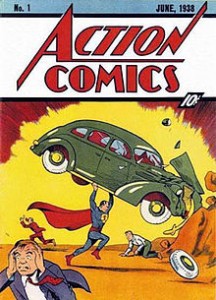 Superman’s debut: Action Comics #1 (June 1938); Cover art by Joe Shuster
Superman’s debut: Action Comics #1 (June 1938); Cover art by Joe Shuster
Superman’s first appearance was in Action Comics #1, published by National Allied Publications, a corporate predecessor of DC Comics, on April 18, 1938 (cover-dated June 1938). In 1939, a self-titled series was launched. The first issue mainly reprinted adventures published in Action Comics, but despite this the book achieved greater sales. The year 1939 also saw Superman appear in New York World’s Fair Comics. Superman would eventually appear throughout a host of titles, including World’s Finest Comics.
Initially Jerry Siegel and Joe Shuster provided the story and art for all the strips published. However, Shuster’s eyesight began to deteriorate, and the increasing appearances of the character meant an increase in the workload. This led Shuster to establish a studio to assist in the production of the art, although he insisted on drawing the face of every Superman the studio produced. Outside the studio, Jack Burnley began supplying covers and stories in 1940, and in 1941 artist Fred Ray began contributing a stream of Superman covers, some of which, such as that of Superman #14 (February 1942), became iconic and much reproduced. Wayne Boring, initially employed in Shuster’s studio, began working for DC in his own right in 1942 providing pages for bothSuperman and Action Comics. Al Plastino was hired initially to mimic Boring but was eventually allowed to create his own style and became one of the most prolific Superman artists during the Gold and Silver Ages of comics.
In late 1939 a new editorial team assumed control of the character’s adventures. Whitney Ellsworth, Mort Weisinger and Jack Schiff were brought in following Vin Sullivan’s departure. This new editorial team brought in established science-fiction writers Edmond Hamilton, Manly Wade Wellman, and Alfred Bester to script. By 1943, Siegel was drafted into the U.S. Army and as a result his contributions diminished. Don Cameron and Alvin Schwartz joined the writing team, Schwartz teaming up with Boring to work on the Superman comic strip, which Siegel and Shuster launched in 1939.
In 1945, Superboy — the teen Superman in flashback stories — debuted in More Fun Comics #101. The character moved to Adventure Comics in 1946, and his own title, Superboy, in 1949. The 1950’s saw the launching of Superman’s Pal Jimmy Olsen(1954) and Superman’s Girl Friend, Lois Lane (1958). By the 1970’s, Superman was appearing in numerous DC Comics.
In 1986, DC Comics restructured its universe with other DC characters in the 12-issue miniseries Crisis on Infinite Earths, resulting in the publication of “Whatever Happened to the Man of Tomorrow“, a two-part story written by Alan Moore, with art by Curt Swan, George Pérez and Kurt Schaffenberger. The story was published in Superman #423 and Action Comics #583 and presented what Les Daniels notes as “the sense of loss the fans might have experienced if this had really been the last Superman tale.”
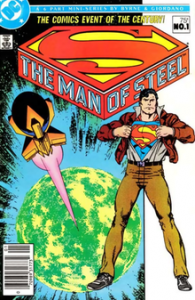 Superman’s origin is revamped in The Man of Steel #1 (July 1986), written and drawn by John Byrne.
Superman’s origin is revamped in The Man of Steel #1 (July 1986), written and drawn by John Byrne.
In 1986, DC relaunched Superman under writer and artist John Byrne, initially in a six-issue weekly series The Man of Steel (1986). A special “direct-sale-only” cover of #1 featured the iconic chest “S” symbol of Superman’s costume. Superman vol. 2 debuted hat year, running through 2006. After it was canceled, The Adventures of Superman was retitled Superman, as Adventures had maintained the issue numbering of the first volume of Superman. Another series, Superman: The Man of Steel, had been launched in 1991, running until 2003, while the quarterly book Superman: The Man of Tomorrow ran from 1995 to 1999. Superman as appeared in numerous other titles throughout the early 21st century.
In 2011, DC Comics again relaunched the Superman comics, along with the rest of the company’s series. Superman and Action Comics were canceled and restarted with #1 issues. Superman’s costume was redesigned to look more like armor and the red shorts over his tights were removed. As of 2013, ongoing publications that feature Superman on a regular basis are Superman, Action Comics and Justice League. The character often appears as a guest star in other series and is usually a pivotal figure in DC crossover story arcs.
Influences
An influence on early Superman stories is the context of the Great Depression. The left-leaning perspective of creators Shuster and Siegel is reflected in early storylines. Superman took on the role of social activist, fighting crooked businessmen and politicians and demolishing run-down tenements. Comics scholar Roger Sabin sees this as a reflection of “the liberal idealism of Franklin Roosevelt‘s New Deal“, with Shuster and Siegel initially portraying Superman as champion to a variety of social causes. In later Superman radio programs the character continued to take on such issues, tackling a version of the Ku Klux Klan in a 1946 broadcast. Siegel and Shuster’s status as children of Jewish immigrants is also thought to have influenced their work. Timothy Aaron Pevey has argued that they crafted “an immigrant figure whose desire was to fit into American culture as an American”, something Pevey believes taps into an important aspect of the American identity.
Siegel himself noted the influence of mythic heroes in the traditions of many cultures, including Hercules and Samson. Scott Bukatman sees the character to be “a worthy successor to Lindberg … [and] also … like Babe Ruth“, and also representative of the United States’ dedication to “progress and the ‘new'” through his “invulnerable body … on which history cannot be inscribed.” Because Siegel and Shuster were fans of pulp science fiction, it is widely assumed that the 1930 Philip Wylie novel Gladiator, featuring a protagonist, Hugo Danner, with similar powers, was an inspiration for Superman, though no confirmation exists for this supposition.
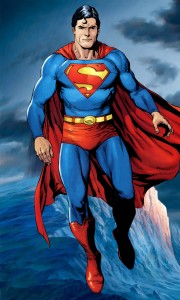 Comics creator and historian Jim Steranko believes that the pulp hero Doc Savage is another likely source of inspiration, noting similarities between Shuster’s initial art and contemporary advertisements for Doc Savage: “Initially, Superman was a variation of pulp heavyweight Doc Savage.” Steranko argued that the pulps played a major part in shaping the initial concept: “Siegel’s Superman concept embodied and amalgamated three separate and distinct themes: the visitor from another planet, the superhuman being and the dual identity. He composed the Superman charisma by exploiting all three elements, and all three contributed equally to the eventual success of the strip. His inspiration, of course, came from the science fiction pulps,” identifying as another possible inspiration “John W. Campbell‘s Aarn Munro stories, about a descendant of earthmen raised on the planet Jupiter who, because of the planet’s dense gravity, is a mental and physical superman on Earth.”
Comics creator and historian Jim Steranko believes that the pulp hero Doc Savage is another likely source of inspiration, noting similarities between Shuster’s initial art and contemporary advertisements for Doc Savage: “Initially, Superman was a variation of pulp heavyweight Doc Savage.” Steranko argued that the pulps played a major part in shaping the initial concept: “Siegel’s Superman concept embodied and amalgamated three separate and distinct themes: the visitor from another planet, the superhuman being and the dual identity. He composed the Superman charisma by exploiting all three elements, and all three contributed equally to the eventual success of the strip. His inspiration, of course, came from the science fiction pulps,” identifying as another possible inspiration “John W. Campbell‘s Aarn Munro stories, about a descendant of earthmen raised on the planet Jupiter who, because of the planet’s dense gravity, is a mental and physical superman on Earth.”
Because Siegel and Shuster were both Jewish, some religious commentators and pop-culture scholars such as Rabbi Simcha Weinstein and British novelist Howard Jacobson suggest that Superman’s creation was partly influenced by Moses, and other Jewish elements. More recently, this interpretation has been endorsed by biographer Larry Tye. For example, Superman’s Kryptonian name, “Kal-El”, resembles the Hebrew words קל-אל, which can be taken to mean “voice of God.” The suffix “el“, meaning “(of) God,” is also found in the name of angels (e.g. Gabriel, Ariel), who are flying humanoid agents of good with superhuman powers. Tye suggests that this “Voice of God” is an allusion to Moses’ role as a prophet. Moreover, Kal-El’s parents send him away in a vessel, delivering him to new adoptive parents in an alien culture in order to save him from impending doom, just as Moses’ parents do. “The narratives of Krypton’s birth and death borrowed the language of Genesis.”
On the other hand, Superman has been seen by others as being an analogy for Jesus, being a savior of humanity. Furthermore, the surname Kent, in early 20th century real life, was a common Americanization of “Cohen,” and Clark Kent’s wimpy, bumbling persona strongly resembled the classic Yiddish schlemiel.
Whilst the term Übermensch, was initially coined by Friedrich Nietzsche and translated by Shaw as Superman, it is unclear how influential Nietzsche and his ideals were to Siegel and Shuster. Les Daniels has speculated that “Siegel picked up the term from other science fiction writers who had casually employed it”, further noting that “his concept is remembered by hundreds of millions who may barely know who Nietzsche is.” Others argue that Siegel and Shuster “could not have been unaware of an idea that would dominate Hitler’s National Socialism. The concept was certainly well discussed.” Yet Jacobson and others point out that in many ways Superman and the Übermensch are polar opposites. Nietzsche envisioned the Übermensch as a man who had transcended the limitations of society, religion, and conventional morality while still being fundamentally human. Superman, although an alien gifted with incredible powers, chooses to honor human moral codes and social mores. Nietzsche envisioned the perfect man as being beyond moral codes; Siegel and Shuster envisioned the perfect man as holding himself to a higher standard of adherence to them.
 Siegel and Shuster have themselves discussed a number of influences that impacted upon the character. Both were avid readers, and their mutual love of science fiction helped to drive their friendship. Siegel cited John Carter stories as an influence: “Carter was able to leap great distances because the planet Mars was smaller that the planet Earth; and he had great strength. I visualized the planet Krypton as a huge planet, much larger than Earth.” The pair were also avid collectors of comic strips in their youth, cutting them from the newspaper, with Winsor McCay‘s Little Nemo firing their imagination with its sense of fantasy. Shuster has remarked on the artists which played an important part in the development of his own style, whilst also noting a larger influence: “Alex Raymond and Burne Hogarth were my idols – also Milt Caniff, Hal Foster, and Roy Crane. But the movies were the greatest influence on our imagination: especially the films of Douglas Fairbanks.” Fairbanks’ role as Robin Hood in 1922 was certainly an inspiration since Shuster admitted to basing Superman’s stance upon scenes from the movie. The movies also influenced the storytelling and page layouts, while the city of Metropolis was named in honor of the Fritz Lang motion picture of the same title.
Siegel and Shuster have themselves discussed a number of influences that impacted upon the character. Both were avid readers, and their mutual love of science fiction helped to drive their friendship. Siegel cited John Carter stories as an influence: “Carter was able to leap great distances because the planet Mars was smaller that the planet Earth; and he had great strength. I visualized the planet Krypton as a huge planet, much larger than Earth.” The pair were also avid collectors of comic strips in their youth, cutting them from the newspaper, with Winsor McCay‘s Little Nemo firing their imagination with its sense of fantasy. Shuster has remarked on the artists which played an important part in the development of his own style, whilst also noting a larger influence: “Alex Raymond and Burne Hogarth were my idols – also Milt Caniff, Hal Foster, and Roy Crane. But the movies were the greatest influence on our imagination: especially the films of Douglas Fairbanks.” Fairbanks’ role as Robin Hood in 1922 was certainly an inspiration since Shuster admitted to basing Superman’s stance upon scenes from the movie. The movies also influenced the storytelling and page layouts, while the city of Metropolis was named in honor of the Fritz Lang motion picture of the same title.
Copyright issues
As part of the deal which saw Superman published in Action Comics, Siegel and Shuster sold the rights to the company in return for $130 and a contract to supply the publisher with material. The Saturday Evening Post reported in 1940 that the pair was each being paid $75,000 a year, a fraction of National Comics Publications’ millions in Superman profits. Siegel and Shuster renegotiated their deal, but bad blood lingered and in 1947 Siegel and Shuster sued for their 1938 contract to be made void and the re-establishment of their ownership of the intellectual property rights to Superman. The pair also sued National in the same year over the rights to Superboy, which they claimed was a separate creation that National had published without authorization. National immediately fired them and took their byline off the stories, prompting a legal battle that ended in 1948, when a New York court ruled that the 1938 contract should be upheld. However, a ruling from Justice J. Addison Young awarded Siegel the rights to Superboy. A month after the Superboy judgment the two sides agreed on a settlement. National paid Siegel and Shuster $94,000 to drop all claims. The pair also acknowledged in writing the company’s ownership of Superman, attesting that they held rights for “all other forms of reproduction and presentation, whether now in existence or that may hereafter be created,” but DC refused to re-hire them.
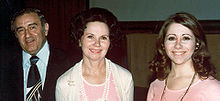 Jerry Siegel, with wife Joanne and daughter Laura in 1976. Joanne and Laura Siegel filed a termination notice on Jerry Siegel’s share of the copyright of Superman in 1999.
Jerry Siegel, with wife Joanne and daughter Laura in 1976. Joanne and Laura Siegel filed a termination notice on Jerry Siegel’s share of the copyright of Superman in 1999.
In 1973 Siegel and Shuster again launched a suit claiming ownership of Superman, this time basing the claim on the Copyright Act of 1909 which saw copyright granted for 28 years but allowed for a renewal of an extra 28 years. Their argument was that they had granted DC the copyright for only 28 years. The pair again lost this battle, both in a district court ruling of October 18, 1973 and an appeal court ruling of December 5, 1974.
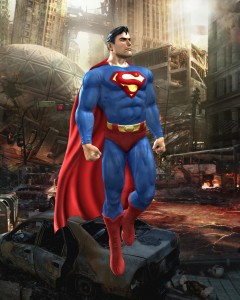 In 1975 after news reports of their pauper-like existences, Warner Communications gave Siegel and Shuster lifetime pensions of $20,000 per year and health care benefits. Jay Emmett, then executive vice president of Warner Bros., was quoted in The New York Times as stating, “There is no legal obligation, but I sure feel there is a moral obligation on our part.” Heidi MacDonald, writing for Publishers Weekly, noted that in addition to this pension, “Warner agreed that Siegel and Shuster would henceforth be credited as creators of Superman on all comics, TV shows, and films.”
In 1975 after news reports of their pauper-like existences, Warner Communications gave Siegel and Shuster lifetime pensions of $20,000 per year and health care benefits. Jay Emmett, then executive vice president of Warner Bros., was quoted in The New York Times as stating, “There is no legal obligation, but I sure feel there is a moral obligation on our part.” Heidi MacDonald, writing for Publishers Weekly, noted that in addition to this pension, “Warner agreed that Siegel and Shuster would henceforth be credited as creators of Superman on all comics, TV shows, and films.”
The year after this settlement, 1976, the copyright term was extended again, this time for another 19 years for a total of 75 years. However, this time a clause was inserted into the extension to allow authors to reclaim their work, reflecting the arguments Siegel and Shuster had made in 1973. The new act took effect in 1978 and allowed a reclamation window in a period based on the previous copyright term of 56 years. This meant the copyright on Superman could be reclaimed between 1994 to 1999, based on the initial publication date of 1938. Jerry Siegel having died in January 1996, his wife and daughter filed a copyright termination notice in 1999. Although Joe Shuster died in July 1992, no termination was filed at that time by his estate.
In 1998, the copyright was extended again with the Sonny Bono Copyright Term Extension Act. This time the copyright term was extended to 95 years with a further window for reclamation introduced. In January 2004 Mark Peary, nephew and legal heir to Joe Shuster’s estate, filed notice of his intent to reclaim Shuster’s half of the copyright, the termination effective in 2013. The status of Siegel’s share of the copyright is now the subject of a legal battle. Warner Bros. and the Siegels entered into discussions on how to resolve the issues raised by the termination notice, but these discussions were set aside by the Siegels and in October 2004 they filed suit alleging copyright infringement on the part of Warner Bros. Warner Bros. counter sued, alleging that the termination notice contains defects, among other arguments. On March 26, 2008, Judge Larson of the United States District Court for the Central District of California ruled that Siegel’s estate was entitled to claim a share in the United States copyright. The ruling does not affect the International rights, which Time Warner holds on the character through DC. Issues regarding the amount of monies owed Siegel’s estate and whether the claim the estate has extends to derivative works such as movie versions will be settled at trial, although any compensation would be owed only from works published since 1999. Time Warner offered no statement on the ruling but does have the right to challenge it. The case was scheduled to be heard in a California federal court in May 2008.
A similar termination-of-copyright notice filed in 2002 by Siegel’s wife and daughter concerning the Superboy character was ruled on in their favor on March 23, 2006. However, on July 27, 2007, the same court issued a ruling reversing the March 23, 2006 ruling. This ruling is currently subject to a legal challenge from Time Warner, with the case as yet unresolved.
A July 9, 2009, verdict on the case denied a claim by Siegel’s family that it was owed licensing fees. US District Court judge Stephen G. Larson said Warner Bros. and DC Comics have fulfilled their obligations to the Siegels under a profit-sharing agreement for the 2006 movie Superman Returns and the CW series Smallville. However, the court also ruled that if Warner Bros. did not start a new Superman film by 2011, the family would have the right to sue to recover damages. Warner Bros hired David S. Goyer to write the script and Christopher Nolan to produce in 2010.
On January 10, 2013, the 9th Circuit Court of Appeals ruled that a 2001 agreement that the Siegel family had reached with DC Comics was still legally binding, thus quashing the 2008 decision in favor of the Siegels. This effectively ensured DC Comics’ sole copyright to Superman.
Fictional character biography
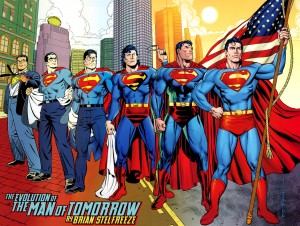 Publication history of Superman – Superman (Earth-Two) and Superman (Earth-One)
Publication history of Superman – Superman (Earth-Two) and Superman (Earth-One)
Superman, given the serial nature of comic publishing and the length of the character’s existence, has evolved as a character as his adventures have increased. The details of Superman’s origin, relationships and abilities changed significantly during the course of the character’s publication, from what is considered the Golden Age of Comic Books through the Modern Age. The powers and villains were developed through the 1940s, with Superman developing the ability to fly, and costumed villains introduced from 1941. The character was shown as learning of the existence of Krypton in 1949. The concept itself had originally been established to the reader in 1939 in the Superman comic strip.
The 1960’s saw the introduction of a second Superman. DC had established a multiverse within the fictional universe its characters shared. This allowed characters published in the 1940’s to exist alongside updated counterparts published in the 1960’s. This was explained to the reader through the notion that the two groups of characters inhabited parallel Earths. The second Superman was introduced to explain to the reader Superman’s membership in both the 1940’s superhero team the Justice Society of America and the 1960’s superhero team the Justice League of America.
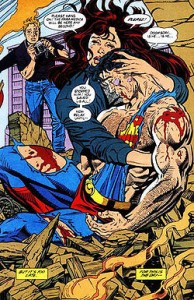 Superman dies in Lois Lane‘s arms: Supermanvol., 2, #75 (Jan. 1993); Art by Dan Jurgens and Brett Breeding
Superman dies in Lois Lane‘s arms: Supermanvol., 2, #75 (Jan. 1993); Art by Dan Jurgens and Brett Breeding
The 1980’s saw radical revisions of the character. DC decided to remove the multiverse in a bid to simplify its comics line. This led to the rewriting of the back story of the characters DC published, Superman included. John Byrne rewrote Superman, removing many established conventions and characters from continuity, including Superboy and Supergirl. Byrne also re-established Superman’s adoptive parents, The Kents, as characters. In the previous continuity, the characters had been written as having died early in Superman’s life (about the time of Clark Kent’s graduation from high school).
In 1992 Superman was killed by the villain Doomsday, although the character was soon resurrected the following year. Superman also marries Lois Lane in 1996. His origin is again revisited in 2004. In 2006 Superman is stripped of his powers, although these are restored within a fictional year.
After a confrontation with Brainiac that results in his father’s death, Superman discovers the lost city of Kandor, which contains 10,000 Kryptonians. Their stay on Earth causes trouble, and the Kryptonians create their own planet, New Krypton. Eventually, New Krypton wages war against Earth. The two sides sustain major casualties and most of the Kryptonians are killed. Superman then starts a journey to reconnect with his adopted home world.
In 2011, DC Comics relaunched its entire line of comic books, including theSuperman franchise, in order to make the characters more modern and accessible. In the new continuity, Clark is no longer married to Lois and his parents died when he was in high school. Superman wears a ceremonial battle armor which pays tribute to his Kryptonian heritage. The armor is similar to his classic outfit, with the difference of lacking the traditional red briefs.
Age and birthday
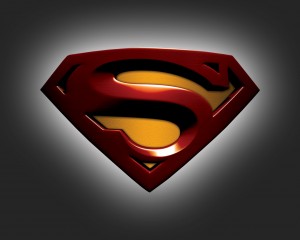 Superman’s age has varied through his history in comics. His age was originally left undefined, with real time references to specific years sometimes given to past events in Golden Age and early Silver Age comics. In comics published between the early 1970’s and early 1990’s, his age was usually cited as 29 years old. However, during The Death of Superman storyline, Clark’s age was given as 34 years old (in a fictional promotional newspaper published), while 1994’s Zero Hour timeline established his age as 35.
Superman’s age has varied through his history in comics. His age was originally left undefined, with real time references to specific years sometimes given to past events in Golden Age and early Silver Age comics. In comics published between the early 1970’s and early 1990’s, his age was usually cited as 29 years old. However, during The Death of Superman storyline, Clark’s age was given as 34 years old (in a fictional promotional newspaper published), while 1994’s Zero Hour timeline established his age as 35.
In the Golden Age, 1950’s Action Comics #149 gives October as Superman’s birthdate. In Silver Age and Bronze Age stories, Superman’s birthday is described as being on February 29, as shown in Superman Annual #11 in 1985. Clark Kent, meanwhile, would celebrate his birthday on June 18, the date the Kents first found Clark (June 18 is also the birthdate of Superman voice actorBud Collyer). Post-Crisis stories also reference February 29 as Clark Kent’s birthday, as shown in Action Comics #655 (July 1990). However, 2009’s Superman: Secret Origin depicts Clark celebrating his birthday on December 1.
Personality
In the original Siegel and Shuster stories, Superman’s personality is rough and aggressive. The character often attacks and terrorizes wife beaters, profiteers, lynch mobs, and gangsters in a rough manner and with a looser moral code than audiences today might be used to. Although not as ruthless as the early Batman, Superman in the comics of the 1930s is unconcerned about the harm his strength may cause. He tosses villainous characters in such a manner that fatalities would presumably occur, although these are seldom shown explicitly on the page. This came to an end in late 1940 when new editor Whitney Ellsworth instituted a code of conduct for his characters to follow, banning Superman from ever killing. The character was softened and given a sense of idealism and humanitarianism. Ellsworth’s code, however, is not to be confused with “the Comics Code,” which was created in 1954 by the Comics Code Authority and ultimately abandoned by every major comic book publisher by the early 21st century.
Today, Superman is commonly seen as a brave and kind-hearted hero with a strong sense of justice, morality, and righteousness. He adheres to an unwavering moral code instilled in him by his adoptive parents. His commitment to operating within the law has been an example to many citizens and other heroes but has stirred resentment and criticism among others, who refer to him as the “big blue boy scout.” Superman can be rather rigid in this trait, causing tensions in the superhero community. This was most notable with Wonder Woman, one of his closest friends, after she killed Maxwell Lord. Booster Gold had an initial icy relationship with the Man of Steel but grew to respect him.
Having lost his home world of Krypton, Superman is very protective of Earth, and especially of Clark Kent’s family and friends. This same loss, combined with the pressure of using his powers responsibly, has caused Superman to feel lonely on Earth, despite his friends and parents. Previous encounters with people he thought to be fellow Kryptonians, Power Girl (who is, in fact from the Krypton of the Earth-Two universe) and Mon-El, have led to disappointment. The arrival of Supergirl, who has been confirmed to be not only from Krypton but also his cousin, has relieved this loneliness somewhat. Superman’s Fortress of Solitude acts as a place of solace for him in times of loneliness and despair.
![]() In Superman/Batman #3 (Dec. 2003), Batman, under writer Jeph Loeb, observes, “It is a remarkable dichotomy. In many ways, Clark is the most human of us all. Then … he shoots fire from the skies, and it is difficult not to think of him as a god. And how fortunate we all are that it does not occur to him.” In writer Geoff Johns‘ Infinite Crisis #1 (Dec. 2005), part of the 2005 – 2006 “Infinite Crisis” crossover storyline, Batman admonishes him for identifying with humanity too much and failing to provide the strong leadership that superhumans need.
In Superman/Batman #3 (Dec. 2003), Batman, under writer Jeph Loeb, observes, “It is a remarkable dichotomy. In many ways, Clark is the most human of us all. Then … he shoots fire from the skies, and it is difficult not to think of him as a god. And how fortunate we all are that it does not occur to him.” In writer Geoff Johns‘ Infinite Crisis #1 (Dec. 2005), part of the 2005 – 2006 “Infinite Crisis” crossover storyline, Batman admonishes him for identifying with humanity too much and failing to provide the strong leadership that superhumans need.

